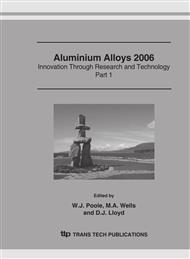p.1421
p.1429
p.1435
p.1441
p.1447
p.1453
p.1461
p.1467
p.1473
The Important Role of Dissolved Elements (Mn, Fe) in the Process of Rolled Products and Their Effects on Final Properties
Abstract:
The important role of dissolved elements, such as manganese or iron, in the production process of rolled material was in the focus of this investigation. In the AlMn-alloys the content of manganese in solid solution is first controlled by other alloying elements such as silicon and iron. The addition of silicon or / and iron reduces the level of manganese in solid solution in the as-cast condition as well as in the following preheating process step. Another major parameter is the final annealing treatment of the rolled products. The preheating treatment and the final annealing are the key parameters to control the level of manganese in solid solution and the size and distribution of the fine dispersoids. In the AlFe-series alloys the iron content in solid solution is first controlled by the casting process DC or CC and the amount of iron in the alloy composition. In the as-cast condition the dissolved iron level is normally higher in the CC-material than in the DC-material. The intermediate annealing treatment also has a great influence on the content of iron in solid solution. They recovery and recrystallisation behaviour is controlled by the content of manganese or iron in solid solution. The precipitation of manganese or iron during thermal treatment leads to optimum dislocation pinning and results in a high thermal stability. On the other hand, if the precipitation of manganese or iron interacts with the occurence of recrystallisation, the resulting grain structure can show coarse grain.
Info:
Periodical:
Pages:
1447-1452
Citation:
Online since:
July 2006
Authors:
Keywords:
Price:
Сopyright:
© 2006 Trans Tech Publications Ltd. All Rights Reserved
Share:
Citation:


